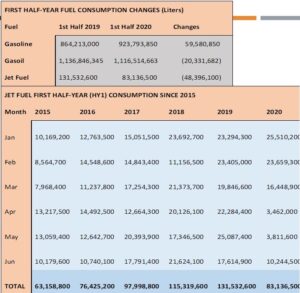Consumption of jet fuel is set to rise again, after experiencing significant falls due to the COVID-19 pandemic, on the back of the reopening of Kotoka International Airport (KIA), the country’s international airport to allow in flights from around the world.
An analysis of the data from the National Petroleum Authority (NPA) by the Institute for Energy Security (IES) shows that jet fuel, also known as Aviation Turbine Kerosene (ATK), for the first half of the year, experienced a big decline of 36.8 percent, as it dipped by a huge 48.40 million liters, over 2019 figure of 131.53 million liters.
According to data from the NPA, Jet fuel uptake in Ghana was at 16.45 million liters in March, falling from 23.66 million liters in February, after the ban on both international and domestic flights was effected.
Prior to the Government of Ghana (GoG) placing stringent restrictions on travel by ordering the closure of Ghana’s land, sea, and air borders to human traffic effective midnight, 22 March 2020, jet fuel consumption in January was 25.51 million; a little above January 2019 figure of 23.3 million liters.
Nana Amoasi VII, Executive Director of IES, noted that despite favorable pump prices occasioned by recent falling of global oil prices, consumption of petroleum products across the globe experienced a dramatic fall.
“The spread of the coronavirus significantly slowed economic activity across the globe. Travel restrictions and flight cancellation across the world, as well as the closure of shops and production outlets in China and around the world, induced less demand for oil and fuels,” he said in an interview with the B&FT.
“With the announcement of the commencement of international flights into and out of the country, the demand for this essential fuel for flights is expected to grow to possibly pre-COVID-19 levels. Consumption could also possibly surge past February 2020 levels, should the momentum be maintained.
The trend of an increasing number of flights to and from Ghana will directly affect jet fuel consumption in the country. Given the recent data from the World Health Organization, the end of COVID-19 crisis seems closer. If that becomes the case, we foresee Ghana recording close to 170 million liters in Jet fuel consumption at close 2020; as airline companies, entertainment, and tourism sectors bounce back in business,” he added.
The data showed further that consumption of jet fuel got worse with the cessation of movement into and out of the Accra, the capital city via aeroplanes. In April and May, Jet fuel consumption was recorded as 3.46 million liters and 3.81 million liters respectively. April and May’s consumption was supported by fueling from international cargo flights.
Consumption spiked to 10.24 million liters at end June 2020 after the resumption of  domestic flight operations on May 1, 2020, to the two major destinations from Accra to Kumasi to Tamale.
domestic flight operations on May 1, 2020, to the two major destinations from Accra to Kumasi to Tamale.
The consumption of Jet fuel in Ghana has grown steadily over the last three decades, rising from 113.51 million litres in 1999 to 287.48 million litres in 2019. Between 2015 and 2019, annual consumption has grown by roughly 37 million litres on average terms. However, for the COVID-19 crisis, consumption for 2020 could have been anywhere in the region of 320 million litres.
The data, which covered all fuel consumed locally showed that in the first half of 2020 (HY1/2020), consumption of domestic liquid fuels including Kerosene, Fuel oil, Naphtha, Gasoil (Diesel) and Gasoline (Petrol) in Ghana remained largely unchanged when compared  to the same period in 2019.
to the same period in 2019.
The total quantity of liquid fuel consumed in HY1/2020 of roughly 2.24 billion liters, compares to 2019’s figure of 2.28 billion liters, in spite of the COVID-19 pandemic. Whereas Gasoline demand grew by 59.58 million liters (6.9%) over 2019 first half-year (HY1/2019) figure of 864.21 million liters; demand for Gasoil fell by 20.33 million liters (-1.8%) over the same period.










